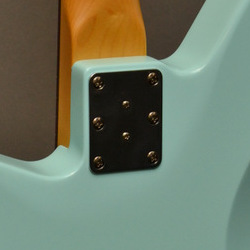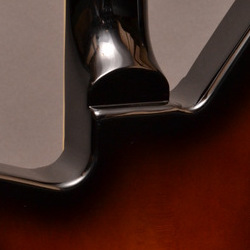If you've spent any time checking out the Reverend guitars on our site you may have noticed that they are organized into two distinct Series: Bolt-On and Set-Neck instruments. I’ve been getting a lot of questions recently regarding which I prefer and why. So it’s time to write about it here in the blog.
Before we begin, let’s take a quick look at what the two neck joints actually are.
A Bolt-On neck is pretty self explanatory. On a Bolt-On neck is seated into a routed out pocket in the guitar body and secured to the body using a number of bolts. In the case of Reverend guitars the number of bolts is usually 6. If you felt like it you could take the strings off of your Bolt-On guitar, unscrew all of the bolts and take the neck off, all in about 5 minutes.
Set-Neck guitars on the other hand have a permanently affixed neck. Just as with a Bolt-On, the neck is cut to fit into a slot on the guitar’s body. However instead of simply screwing it in place the Set-Neck is glued in place. This neck is not really meant to be removed from the guitar at any point in it’s life.


Bolt-On Set-Neck
If you spend any time in guitar forums you may have seen some friendly discussions (Or angry debates for that matter) about the pros and cons of both neck joints. Like all aspects of their instruments, the neck joint used is something that some players can get very opinionated about, digging their feet into the dirt and letting you know in no uncertain terms that their preference sounds better. But does it?
The prevailing opinion I’ve found online is that Set-Neck guitars carry vibrations better than a Bolt-On. This means that, in theory, the Set-Neck guitar should vibrate more easily and the sustain of the notes should be longer than on a comparable Bolt-On guitar. The amount of difference claimed has a lot to do with who you ask. Some players will say that there is a slight difference while others will assert that the difference is huge (I get visions of Nigel Tufnel from Spinal Tap when I hear this).
Personally, I don’t buy it.
I’ve played a lot of electric guitars over the years and even more electric basses and I’ve played good and bad examples of both neck joint styles. To me the real deciding important factor is simply how tight of a neck joint you have. A poorly seated Set-Neck is going to sound worse than a tight fitting Bolt-On and vice versa. The name of the game is simply to let the vibration travel through the entire length of the guitar as easily as possible. You want to feel the instrument resonate in your midsection when you're playing it. To put it simply, even if it is a bit of a cliche, the guitar should feel "alive" when you play it. If the neck is properly executed and the guitar is resonant I don’t really care what method the manufacturer took to get it there.
One of the biggest issues when comparing two different neck joint styles is that rarely if ever is it an “all else is equal” kind of situation. Beyond the sustain, I’ve read some articles where the author explains how Bolt-On necks “are more articulate” or how Set-Necks are inherently warmer sounding. In situations like this I feel that these writers are really overlooking the fact that a guitar is the sum of it’s parts. If I pick up two different Reverend instruments, one with a Bolt-On and one with a Set-Neck, there are going to be a lot more differences than just the neck joint style. The scale length is probably going to be different (Bolt-On Reverends tend to be long scale while Set-Necks tend to be short scale). The pickups may be different styles or in different positions. One can have a Wilkinson tremolo while one has a Bigsby. Even the mass of the two bodies can be different depending on how they’re styled. All of these things are going to impact the final sound of an instrument so you can’t really just say that it’s because of the neck joint. Maybe the neck joint is playing a part, but so is everything else.
With this said, I feel that there are two differences between the neck joints that I should bring up. The first is that, if you’re the kind of person who likes to play high up on the fretboard you might prefer the Set-Neck simply because it doesn’t have as pronounced of a heel on the back of the neck to impede movement. This isn’t to say that it’s impossible to play on the last few frets on a Bolt-On neck (David Gilmore sure pulled it off) but it’s certainly a bit harder.
The other difference has to do with repairability. Let’s say that the world conspires against you and your guitar suffers serious damage. Maybe you’re loading up at the end of a gig and it’s case get’s run over and your neck is trashed. What do you do? Well with a Bolt-On neck you can find or make a neck that will fit into the guitar, unscrew the old neck and bolt on the new one. But what if you have a Set-Neck? Technically it’s still possible to replace a broken neck on a Set-Neck guitar, but it’s no longer a matter of just swapping them out in a half an hour. It takes a lot of know-how to replace a Set-Neck and, unless you happen to be a luthier yourself, it’s may end up costing as much as the instrument did in the first place.
Or let’s think about a slightly less dramatic example, adjusting neck angle. Neck angle is exactly that, the angle of the neck in relation to the body. A good neck angle can mean a low, comfortable action and a good transference of vibration. All of the Reverends I’ve seen arrive at our store have had a great neck angle right out of the box. However, just like acoustic instruments, an electric guitar is not static. How it plays today is not an indication of how it’s going to play in 10 years. This is because the tension the strings exert on the body over the years can start to actually make it a bit more concave and therefore throw the neck angle off. Now with a Bolt-On neck you can put a shim in the neck pocket to adjust this angle back to where it should be. Some Bolt-Ons even have an adjustment screw built into the neck plate to adjust the neck angle without any shims at all. Unfortunately, because of their inherent design, this option isn’t really viable for Set-Neck guitars
So why does Reverend bother making both styles of neck? Why not just make all of their instruments one or the other and call it a day? The answer is tradition and style. I've said it before that Reverend is a company that rides that fine line between sticking to what works and respecting tradition and being innovative and improving on tried and true designs. When it comes to their neck joints I feel that they seem to play it a little more safe on tradition. We're simply just used to seeing certain body styles with one neck shape or another. Take the Six Gun for example, which was obviously inspired by the Fender Stratocaster. The shape of this model is just so commonly seen with a Bolt-On neck that honestly I think they’d look a little weird without one. The same goes true for a Les Paul style guitar without a Set-Neck. Would it work? Absolutely, but it would just seem a little off compared to what we’re used to seeing.
So, at the end of the day, my only real piece of advice when choosing between the Reverend Bolt-On and Set-Neck series instruments is to pick whichever one is more fun to play. Personally I tend to prefer their Bolt-On offerings, but I don’t prefer them because they’re Bolt-Ons. I tend to like the feel of their longer scale length and the sound that provides and, if I had to be honest, I think I like the style a bit more. But then I have friends who love their Set-Neck guitars for those same reasons.
Do you consider the neck joint style when picking an electric guitar? Be sure to let us know why in the comments below.